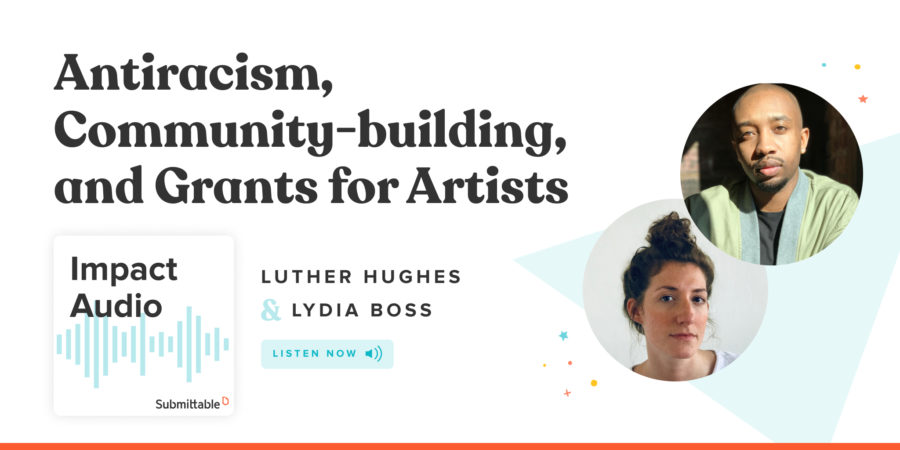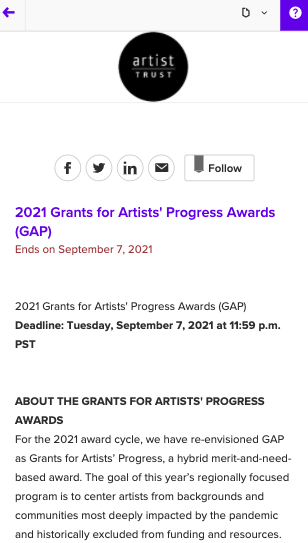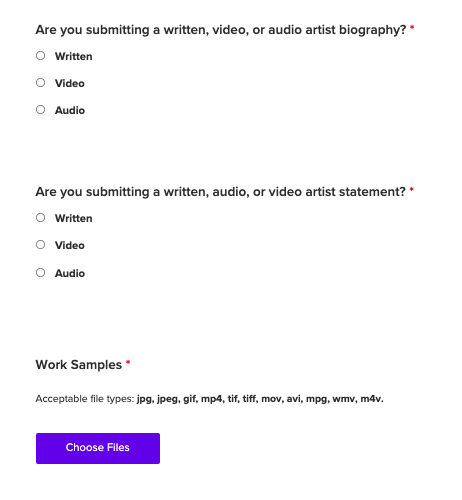Many folks agree with the idea of equity in theory, but when it comes to implementing strategies to directly address entrenched biases, they sometimes get stuck. But antiracist work requires action. Past inequity ensures that taking a passive, “color blind” approach will only perpetuate the historical prioritization of certain voices and the underrepresentation of others.
Although it can feel like a heady topic to address, any progress toward equity is always underpinned by a tangible strategy. Taking time to identify how to move your organization toward more inclusive processes will help you center equity in your mission.
Artist Trust is an organization dedicated to supporting artists across Washington State. Increasingly, the organization has become intentional about implementing practices that reinforce equity and hold the institution accountable for its progress toward these goals.
Artist Trust program managers Lydia Boss and Luther Hughes shared some of what they’ve learned with us, including strategies you can put into practice right away.

Three essential practices
Collaboration is key
The first step in doing any antiracist work is understanding yourself as part of a larger community. Take a step back and look at the people and organizations around you doing equity work. Even if you’re not working with them directly, you are in partnership with them in pursuing these larger goals.
You also need to think about the community you serve. You want to be in conversation with them. Open up lines of communication and be open to their feedback. Community members are an incredible resource since they have a clear sense of what is happening on the ground.
Doing antiracist work often requires asking hard questions; without a strong relationship built on trust, it’ll be difficult to start these complex conversations.
Shift your focus from the transactions of grantmaking to relationship building. Be curious about the work your grantees do and invest time into connecting with them on a deeper level.
Doing antiracist work often requires asking hard questions; without a strong relationship built on trust, it’ll be difficult to start these complex conversations.
Not only do you need to rethink the relationships you create with your grantees, you need to recalibrate the culture within your organization. Create opportunities for collaboration and honest dialogue. Antiracist work can be difficult; you need a network of support to do it right.

“The whole team knows this work can’t be done alone, you need each other to support and push and have someone taking risks with you,” Hughes says.
Look at your whole organization
When so much of your work revolves around grantees, it’s easy to get focused on them and forget about the other components of your organization. But trying to advance equity for grantees without doing so for employees and board members will undercut your efforts as well as your authenticity.
Look for ways to address inequity. For Artist Trust, this meant being transparent with salaries.
“Our finance manager took the risk and said, let’s have some salary transparency. Let’s all get together and look at who makes what and have a conversation about: is this equitable?” Boss explains.
Artist Trust also compensates the panelists who help them judge grant applications. This ensures that folks aren’t left out of the conversation because they cannot afford to donate unpaid time to the process.
We really recognize that the future success of artists does need to be about centering artists as experts. And that means not just in their art, but also in design, in communications, creative strategy, and community building.
Of course you want to implement practices that ensure you are awarding grants fairly, but you also want to think bigger than that when it comes to your grantees. Empower them in the work they do, but also amplify their voices when it comes to planning, communication, and shaping policy.

“We really recognize that the future success of artists does need to be about centering artists as experts,” Boss says. “And that means not just in their art, but also in design, in communications, creative strategy, and community building.”
Don’t forget about your donors. Include them in this conversation. Often grantmakers are hesitant to bring up issues that could alienate donors, but positioning the conversation as an invitation to do this antiracist work together can help. Putting in the effort to get everyone on board from the start will allow you to take more risks and be more vocal about the work you’re doing.
Formalize the work
Like any strategic goal, equity work needs a solid framework. Starting conversations around the issue is important, but it’s not enough.
You need to find ways to set specific goals, measure progress, and ensure accountability.
Without a formal team, equity work can get lost in the shuffle. You’re busy running programs and helping grantees. Think about creating a team to oversee your equity work. After setting intentions around becoming anitracist, Artist Trust created a dedicated Racial Equity Committee which includes both board and staff members. This committee ensures that the conversation around equity won’t ever get lost behind other priorities.
Be careful not to think of your equity task force as an island. This group’s ideas should help shape work across the organization.
“There’s also the expectation that [the racial equity] committee’s work and members from this committee will then go to other board committees and make sure that work that’s happening on the finance committee is being done through a lens of racial equity or work being done on board governance is being done through a lens of racial equity,” Boss says.
You need to find ways to set specific goals, measure progress, and ensure accountability.
If you have specific goals to address bias in your grantmaking, you‘ll need to collect data. This may be demographic, geographic, or other data. Doing this will allow you to understand where you’re starting and measure your progress over time. Analyze the data to hold yourselves accountable. Are you reaching the communities you want to reach? Do the numbers reflect an inclusive and equitable process?
Get serious about your data
Learn how to collect demographic data to meet your DEI goals in our hands-on workshop.
Sometimes it’s hard to see clearly when you’re so close to the work. Setting up an external audit can give you an honest, unbiased picture of your progress. Artist Trust found this to be a valuable tool.
9 strategies for improving equity in your grantmaking process
1. Streamline the process for grantees
Making your application as simple and straightforward as possible will go a long way in attracting a diverse and varied pool of applicants. Choose a platform that’s easy to use and that can house all application materials in one place. Even better if it’s mobile-friendly and can be completed on a device.

“Applying for grants is pretty difficult sometimes and pretty time-consuming,” Hughes says. “And so we want to make the process feel less time consuming, less difficult, and more accessible.”
Simplify the requirements as much as possible. You don’t want to discourage folks who would qualify because they don’t have time to sort through a complicated application or they don’t meet an arbitrary requirement.
2. Prioritize accessibility and approachability
As you create application materials, use friendly language that invites people in. Avoid using overly academic or jargony language. You don’t want to exclude folks just because they are confused or intimidated by the tone of the application.
Find unique ways to make information available. Artist Trust created a virtual study hall program, which allowed potential applicants to drop in and ask questions. They had the opportunity to chat with staff members and other applicants and start to build a sense of community. “You pop into a Zoom room,” Hughes explains. “It’s public, obviously, and you just kind of ask us questions about the application, about the grant process, and about the panelists selection process.”
3. Let people self-identify
If you’re trying to reach certain demographics with your grants, don’t just try to guess how they identify. Ask them. And let folks tell their story in their own words. This means you can’t just create a list of identities and make applicants choose one. Give them options to describe how they identify and which groups they see themselves belonging to.
We allowed the applicants to self-select into demographic groups and into narrative, so that they can say for themselves who they are and let us know who they are and who they identify with.
Keep in mind that many identities are not mutually exclusive. Embracing intersectionality will allow your organization to make space for a wider range of voices and honor the richness of your grantees’ experiences.
“We allowed the applicants to self-select into demographic groups and into narrative, so that they can say for themselves who they are and let us know who they are and who they identify with,” Hughes says.
4. Shift away from project-based grants
This one takes trust and a long-term vision. Although project-based grants allow you to point directly to the output of work you helped fund, they can be quite limiting for grantees. If someone can use their grant money only for costs directly related to a project, they might not be able to address broader issues preventing them from doing the work they want to do (e.g., paying rent for a workspace).
Artist Trust has made the shift away from project-based grants. They understand that their grantees are people with complex lives. Restricting how artists can use their grant money doesn’t benefit anyone.
“Artists don’t need to be told what to do with the money that we give them,” Boss says. “Artists know how to use that money to support their life and their work.” Artist Trust understands that an effective mechanism of support might look different for everyone.
5. Value qualitative impact reporting
It’s easy to get caught up in the numbers when it comes to impact reporting. But advancing equity means valuing qualitative data as well. If you’ve done the work to forge meaningful relationships with grantees, then reach out to them and ask about the work they’re doing. Sometimes the most meaningful impact cannot be boiled down to a simple metric.
When you measure and report on your impact, weave these narratives in to create a full picture of the breadth and depth of your program.

“I believe that for sure, numbers play a big part in how we’re talking about things and how we’re doing the ‘work’, but also understand that experience is also as qualitative as numbers and numerical impact,” Hughes says.
6. Educate everyone involved
If you’ve created a committee or task force to plan and track your equity work, that’s great, but they shouldn’t be the only ones involved in the conversation. Educate everyone across your organization about the work you’re doing and the principles at its core. Be sure to talk about practices you’re putting in place and how each member can implement these in their own work.
Artist Trust brings in guest panelists to help judge the merit of applications. It is essential to include these panelists in the broader conversation around equity.
To do so, Artist Trust created an orientation training to help address implicit and explicit bias and share strategies of how to approach applications with an antiracist lens.
“An orientation is just meeting with the panelists beforehand to kind of go over a lot of the background of the award, to go over the panel process, to go over their roles and duties as panelists and also policies like conflict of interest policies, but really also to talk about what it means to look at the application through the lens of racial equity and to have geographic diversity,” Hughes says.
7. Don’t overvalue professionalism
Oftentimes components of professionalism are meant to reinforce the dominant culture. If you overvalue applicants who look and sound professional to you, you might be disqualifying folks who are doing good work but are outside that dominant culture in some way.
“We explicitly tell our panelists, don’t judge applications based on writing or grammar because writing is a skill and not everybody has that skill to be a professional or a fantastic writer,” Hughes says. “And also everybody might not be not use English as their first language.”
Rather than focusing on things like grammar, rate applications based on their merit. You might even expand your application format to allow folks to explain their work using images or video.

8. Eliminate gatekeeping practices
A big part of becoming antiracist is seeking to open doors that have previously been closed. You want to do away with practices that shut people out because they don’t know the right people or they haven’t been part of your community in the past.
In this vein, Artist Trust eliminated the requirement for recommendations. They realized recommendations were not adding much value to the applications but they were serving as a barrier for some. Look over your application requirements to see if any are creating an unnecessary hurdle and shutting folks out.
Streamline your grantmaking process
Submittable is an easy-to-use platform that helps you lessen the burden on your grantees and improve equity.
9. Rethink traditional categories
Your organization might have a strong history of supporting a specific kind of work.
As you look ahead, consider whether it might make sense to broaden your understanding of what kind of work qualifies for your support. Be open to work that has been traditionally left out.
As you look ahead, consider whether it might make sense to broaden your understanding of what kind of work qualifies for your support. Be open to work that has been traditionally left out.
For example, Artists Trust has made an effort to support indigenous artists who are focused on storytelling and folk art, two categories that have traditionally been excluded from the canon. In doing so, they are working against entrenched biases and providing resources to a whole new community of artists.
Find the right partner to support your equity work
Equity is not something you can achieve and then forget about; it’s an ongoing conversion. Antiracist work is always evolving. “Racial equity isn’t mathematical—it changes day to day,” Hughes says. “And so, we have to continually take risks.”
To hear more from Lydia Boss and Luther Hughes, check out this Submittable webinar. If you don’t have time to watch the full hour, we’ve highlighted some of the top takeaways in episode three of our social impact podcast series, Impact Audio.
As a social impact platform, Submittable is grant management software that’s positioned well to help you implement equity practices in your grant program. With an easy-to-use platform for grantees, tools for meaningful impact reporting, and the flexibility to create applications that make room for a wide range of voices, it’s an ideal solution for your team. Learn more.